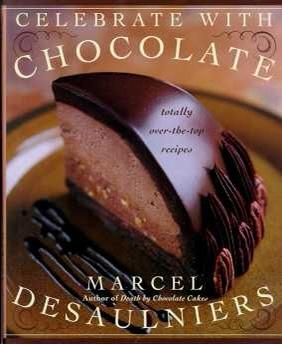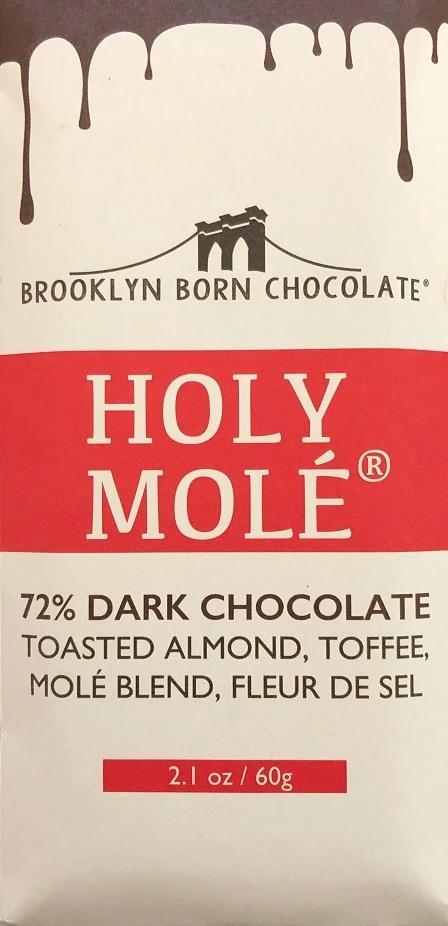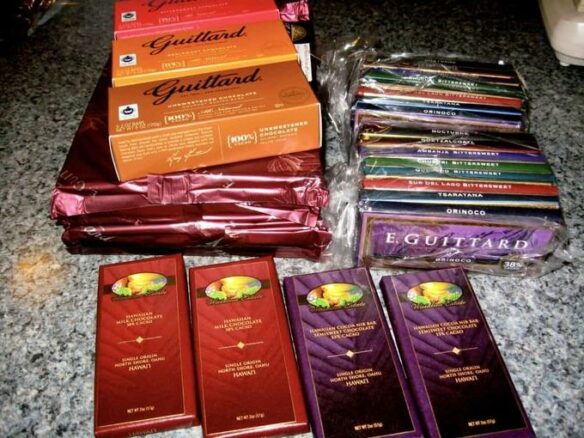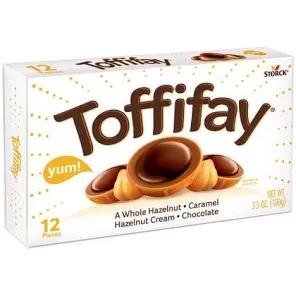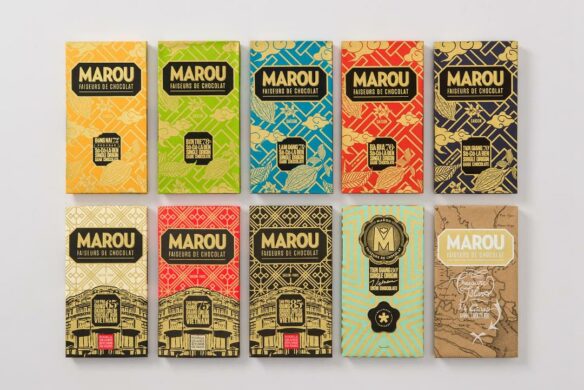
Review by April Gutierrez: “You got your chocolate in my peanut butter! You got your peanut butter in my chocolate!”
Admit it, you’ve got a guilty pleasure or two. We all do. Maybe it’s greasy burgers from the dive joint around the corner from your office. Maybe it’s spaghetti westerns or Japanese kaiju movies. Or racy romance novels. Whatever form it may take, we all find delight in something that perhaps we feel we shouldn’t because it’s against our sensibilities, runs the risk of ridicule, or just plain isn’t good for us.
And so, I have a confession to make. Yes, I have a problem. And that problem’s name is Reese’s Peanut Butter cups. I’m the person at Hallowe’en who looks at the bowl of candy designated for trick-or-treaters and asks, plaintively, “Could we hold the Reese’s in reserve? Or at least hide them on the bottom of the bowl?” and who will blatantly pilfer from the bowl throughout the evening. And if there’s any left over? Bliss!
I could, in a heartbeat, give up the entirety of American mass-produced chocolate (so much of which is of Hershey’s manufacture), so long as I can keep the creamy, chocolaty, salty goodness that is Reese’s Peanut Butter cups. In fact, I might be willing to sell a friend or two out for a steady supply of the things. And it’s not just me, I have a Japanese friend who stocks up when she comes to the States, and is desperate enough that she’s going to try making some of her own in the near future.
Why, you might ask? What’s so addictive about a simple chocolate shell filled with peanut butter? Well, in my case, it’s that chocolate and peanut butter are two of my absolute favorite foods, period. We’re not talking a simple fondness for, but outright devotion. Chocolate is self-explanatory, I think, and peanut butter? Mm, salty, crunchy goodness (all hail today’s organic peanut butter that is 100% peanuts!). Put the two together and you get a sweet ‘n salty bit of heaven. Personally, I think the person who first decided chocolate and peanut butter were “two great tastes that go together” deserves sainthood.
As does Cat, who cheerfully sent me a variety of Reese’s products to devour –- er, review. So we have Reese’s Milk Chocolate Cups, Reese’s Dark Cups, Reese’s new Minis, Reese’s Fast Break bar and Reese’s Pieces. I’m grateful for the lack of white chocolate cups, as that’s just … wrong. (Really, don’t get me started on how white chocolate ain’t chocolate. It’s quite the rant.)
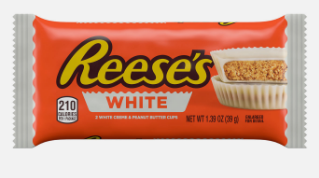
How do I eat my Reese’s? In a couple of bites each, though I should’ve nibbled to savor them.
First up were the dark chocolate cups, as they’re my favorites. I’m not sure of the cocoa content of the dark cups, but it’s probably not much over 50%. Regardless, it does make for an entirely different taste when compared with the milk chocolate cups. Sugar’s a prime ingredient in all of Reese’s products, including the dark chocolate. Normally I’d find this annoying, but the slight sweetness of the dark chocolate against the creamy saltiness of the peanut butter is a little taste of heaven. The chocolate serves as an enhancement to the peanut butter, making the salty taste pop in all the right ways. By contrast, the milk chocolate doesn’t work as well as it’s a bit too bland (think your average Hershey’s milk chocolate) to enhance much of anything, even something with a contrasting taste. Still, I wouldn’t turn away free milk chocolate cups, and indeed, I didn’t!
Next up was a product I’ve been dubious about since I first heard about it – the Fast Break candy bar, which has layers of peanut butter and nougat covered with milk chocolate. Being somewhat of a purist, I didn’t see a need to add nougat into the mix. Why ruin a good thing? I tossed this in the freezer before trying it, which resulted in a satisfying crunch to go with the salty sweetness. The bar is, in fact, quite tasty, but makes me think more of a Snickers bar -– less the actual peanuts -– than a Reese’s product. Nice for a one-time thing, but if I’m craving this particular flavor combo, I’d probably go for the aforementioned Snickers.
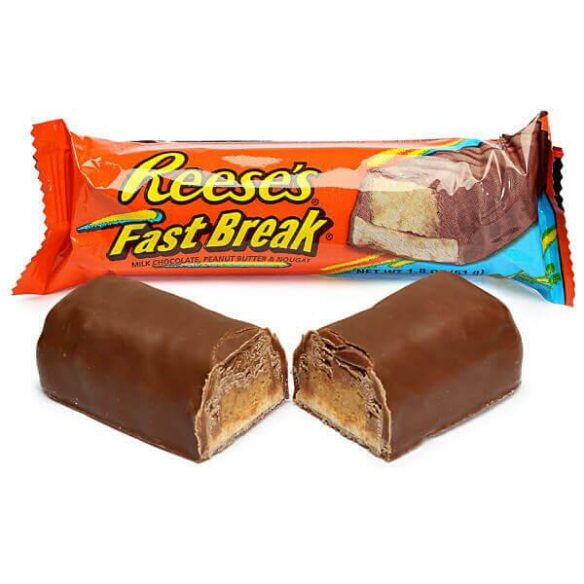
The wrapperless milk chocolate minis are a new product for Reese’s. They came in a “king”-sized bag and there seem to be quite a few of them (no, I didn’t count as I was popping them into my mouth one after another; nor did I even consider checking the caloric content…). Apparently, there’s an even larger bag available, presumably for those who are kind enough to share their Reese’s. While the minis are still just milk chocolate, they proved to be tasty little morsels. Perhaps it’s because they’re gone so quickly, just a momentary burst of flavor on the tongue, that they seemed to taste better than the full-sized milk chocolate cups. I do have to wonder what a dark chocolate version might taste like.

Last, though by no means least, were a bag of Reese’s Pieces, which are candy-coated bites of peanut butter. No chocolate to speak of with the pieces, but there is a lot of creamy peanut butter, set off by the crunch of the candy shell. Probably because of the lack of any real chocolate, the pieces are a bit on the sweet side and not enough of the salty tang that should be there. Still, they’ve got a good mouth feel and they are peanutty enough to be enjoyable should you not have any of the cups available for snacking on.
Reese’s are by no means high quality chocolate. In fact, the chocolate itself tends to be a bit crumbly. And we simply won’t discuss the sugar and fat content of either the chocolate or the peanut butter. But these simple candies have no pretentions of being anything more than they are -– a yummy blend of two great tastes. There are imitators and wanna-bes, but nothing beats a good Reese’s cup when you’re craving peanut butter and chocolate, that’s for damn sure!
Thanks!
April Gutierrez, Japanese fan. A Green Man Review reviewer. A life-long lover of chocolate and felines, she indulges in the former frequently and shares her abode with a rather spoiled specimen of the latter. She can most commonly be found with her nose buried in a book, a cup of good tea in hand and Japanese pop music playing in the background.

